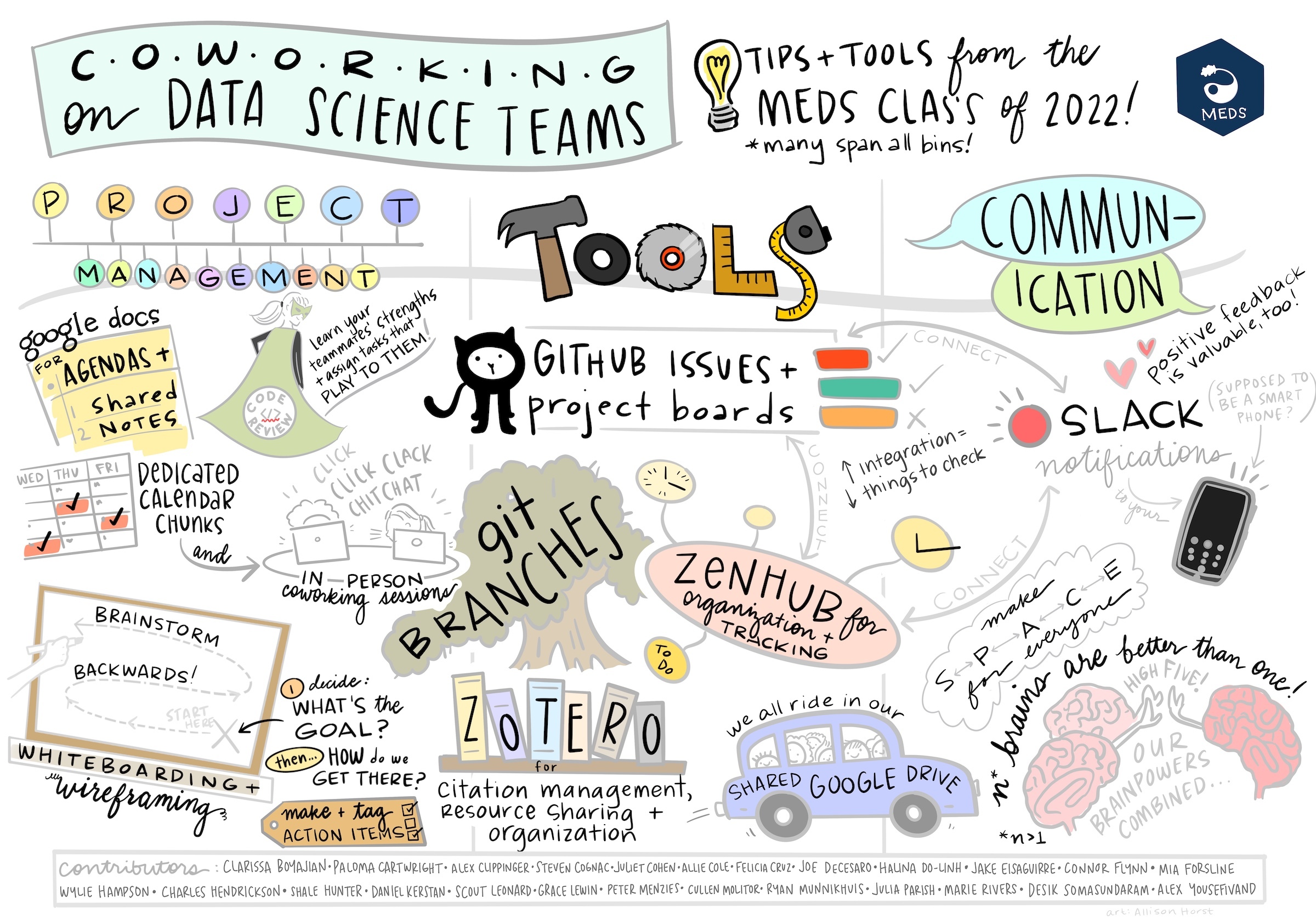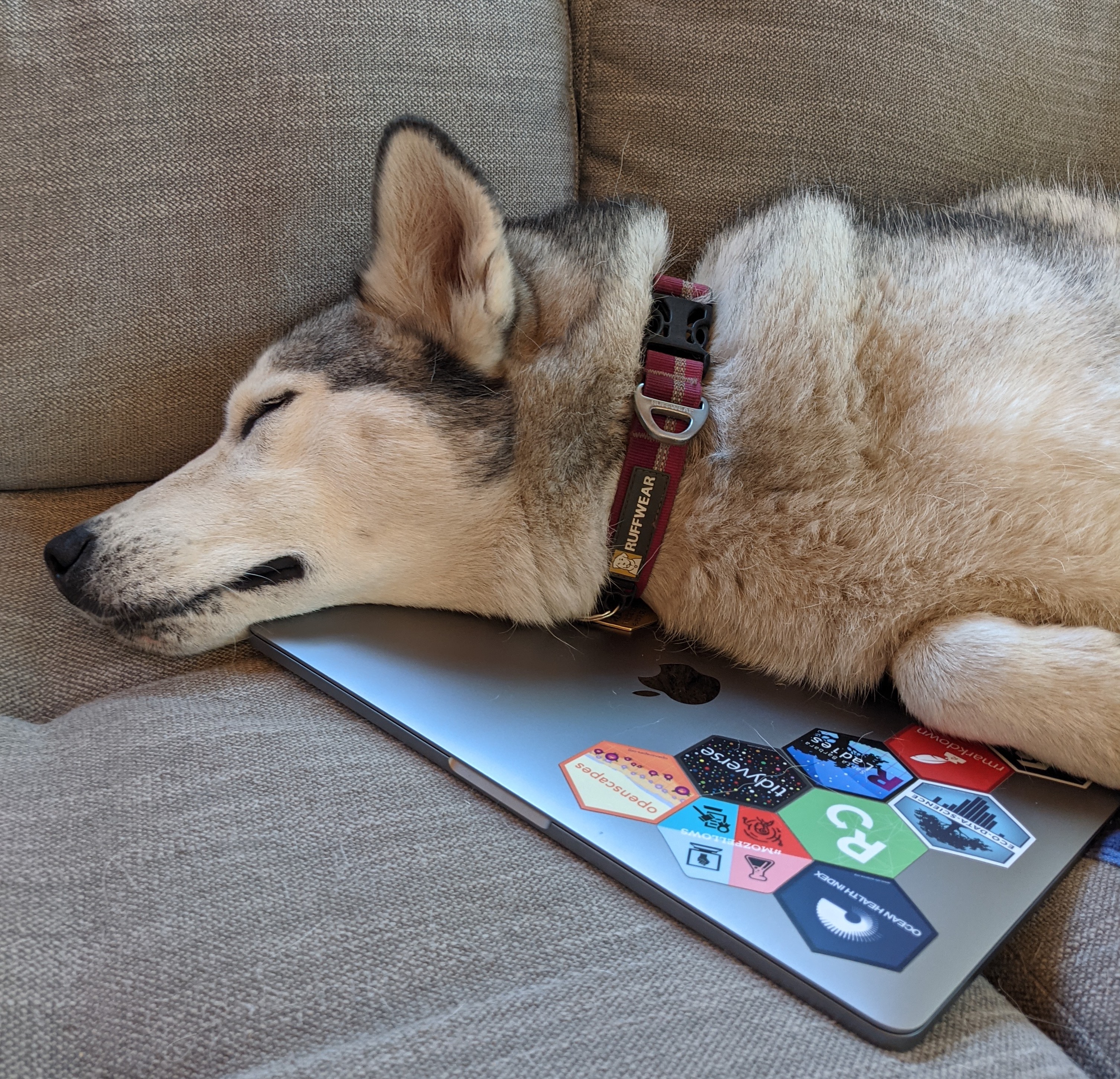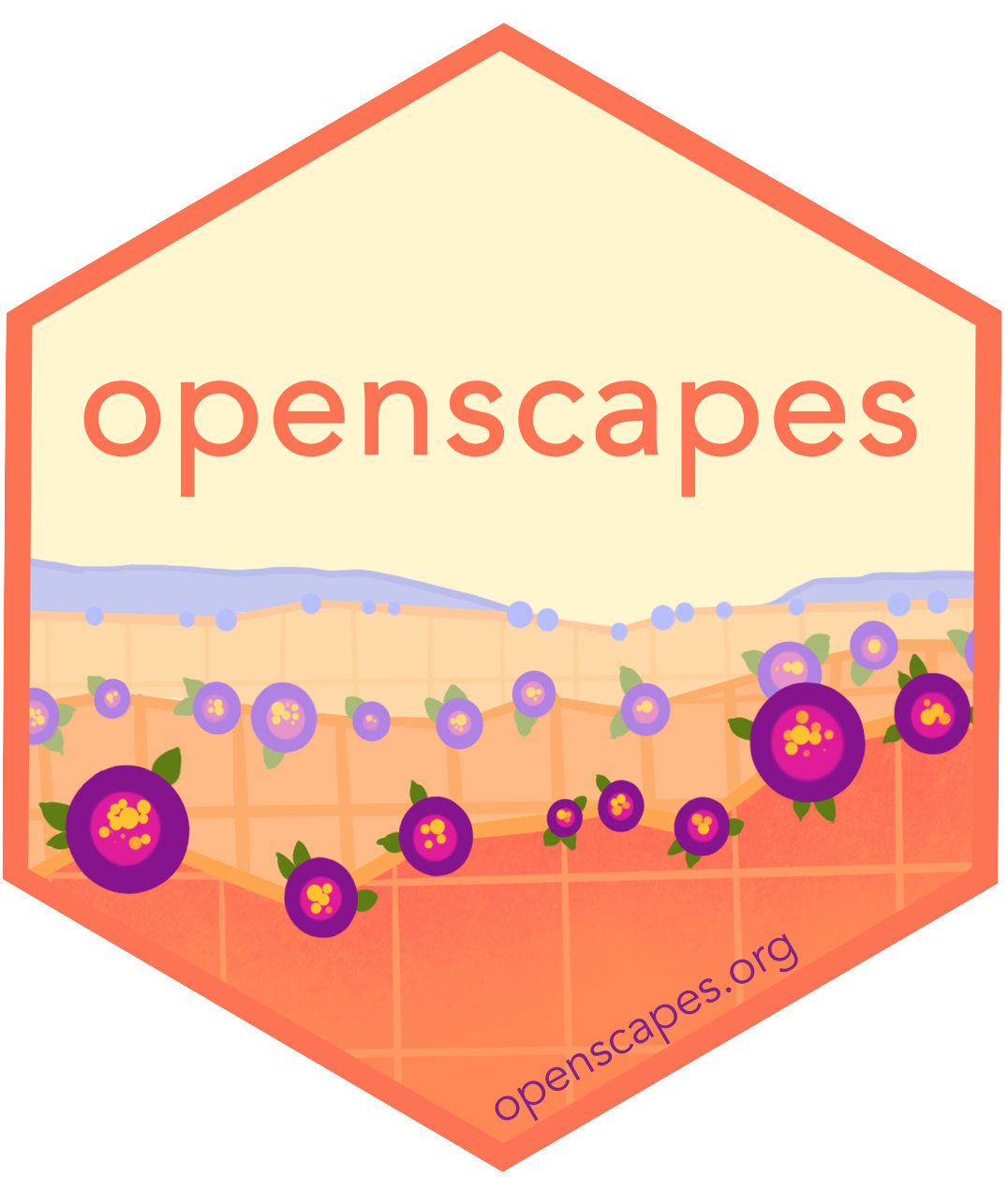Seaside Chats, etc.
We work together with varied technology and facilitations to provide structure. Here are the main ways we work together.

Seaside Chats
We build shared skillsets in part through Seaside Chats. These are regular meetings where we skillshare and learn together. This will likely be the avenue for onboarding. That will be a place where you can get familiar with any of the tooling and practices that we use. And, you can teach the rest of the team what you know so that we can all work better together. These often have an agenda in advance.
Coworking
We also have coworking sessions where we work at the same time together. Sometimes, this means quiet work with check-ins to break up focused work and get feedback, and sometimes this involves screensharing to problem solve. Openscapes staff participates and we draw from our open science network to invite people whose expertise in things like experts in open peer software review or Quarto can help.
Hackathons
We have hackathons to tackle specific tasks together. We use this word to mean working on something together in real time that benefits the project or team. These are often a good way to get early momentum on a project or to re-invigorate an existing project. We kick-started this guide during a 2-person hackathon! We made the github repo, quarto site architecture (section folders, chapter pages, and markdown headers) to outline the guide and built and iterated as we went.
Community Calls
We host ~4 Community Calls per year where we discuss and explore topics relevant to Openscapes. See past and upcoming events that Openscapes has either hosted or joined.
Community Calls are an hour long and generally follow this structure:
- begin 5 mins prior: rotating welcome slides and pump-up music selected by the guest
- 5 mins: welcome, code of conduct, land acknowledgement, plan for the call, introduce guest
- 25 mins: prepared conversation with guest
- 10 mins: moderated questions/discussion from the chat
- 10 mins: open discussion
- finish 5 mins before a full hour
Cohort Calls
Cohort Calls are the core of the Champions Program and the NASA Openscapes Framework. They are described more in the Champions Lesson Series. They are a big part of how we work as we work with research and mentors groups.
One note: we avoid having folks “shadow”on Cohort Calls, since we are building trust and so avoid have folks “drop in”. Instead, we can plan in advance to have them assist and introduce themselves if they are joining a Cohort Calls and learning by doing.
Roll Call Prompts
In virtually every meeting, we start with a silent roll call in a Google Doc, asking participants to add their name, organization, and a response to a prompt as a kind of checkin. Here are some of the prompts we’ve used. Thanks to the Openscapes community for their suggestions.
- What is a good book recommendation?
- A tool you are using these days that you’d recommend
- Something in your work space that is meaningful to you
- Something you’re paying attention to
- What was something that was hard today & what was something great that happened?
- What has been comforting this week/past weeks
- Something that is both a bug and a feature for you (“downfall and superpower” - Eli Holmes)
- What is your favourite nearly-useless superpower?
- Something that is (or is becoming) a habit for you
- Where was your favorite vacation?
- What sloth are you? (from a series of images) 😆
- What was your very first job?
- Sweet or savory?
- What’s your favorite flavor combination?
- Last movie you saw in a theater
- What was the last song you listened to?
- What are you looking forward to?
- What’s coming up for you this fall/spring / this week?
- Share something from the summer/winter so far
- Something you’re grateful for
- Share a place that’s meaningful
- Share someone or something that influences your work
- Something that you did/learned/saw that resonated to you this week
- Share something you’re good at
- Share a song that pumps you up or gives you energy
Land Acknowledgments
We give a land acknowledgement during the welcome of every Cohort Call and Community Call. Following guidance from Ta7talíya Michelle Nahanee through her Nahanee Creative Territorial Acknowledgements Interactive Workshop, we omit the phrase “I would like to acknowledge” and jump right to the statements. Ideally we try to include an action so that people understand that these are more than just words. Here are some examples you can reuse or remix.
- I live and work on the traditional lands of the Tk’emlúps te Secwépemc [she-KWE-pem] within Secwépemc’ulucw [she-KWE-pem-cooluc], the traditional and unceded territory of the Secwépemc [she-KWE-pem] peoples. One thing I do to learn more is attend the annual Kamloopa powwow. Kukstemcw (thank you!) for joining us today.
- To learn more about the land(s) you’re on: https://native-land.ca/. You can also text your zip code to this number and it will tell you the land(s) you’re on: 1-907-312-5085.
- I work on endangered and threatened PNW salmonids. Salmon are central to the Native Nations of the Puget Sound region and coast, the Hoh, Makah, Muckleshoot, Nisqually, Puyallup, Quileute, Skokomish, Lummi, Quinault, Sauk-Suiattle, Squaxin Island, Stillaguamish, Upper Skagit, and Yakama Nations. I see the foresight of the leaders of the Pacific Northwest Native Nations who wrote in clauses to ensure perpetual access to their ancestral fishing locations in the treaties of the mid-1800s. I acknowledge the determination of the next generations who protested on the water and in the courts to force these treaties to be upheld. Now, I work to educate myself on this history and specifically on the Boldt Decision and its aftermath. As a federal employee, I am part of the system that upholds these treaties and court decisions. I am aware that I am not knowledgeable as I want to be and I want to work on this.
- I am grateful I am for the land where I am here in Santa Barbara California and I want to honor the Chumash peoples who have been and continue to be stewards of the lands and waters here.
- Land Acknowledgements are one way to amplify the knowledge and work of Indigenous peoples. Here’s a place you can go to learn more: https://native-land.ca/. I’ve learned more about Indigenous sense of place through Robin Wall Kimmerer’s beautiful book Braiding Sweetgrass - Indigenous Wisdom, Scientific Knowledge, and the Teachings of Plants.
- I acknowledge that the Piscataway Indian Nation continues to maintain a relationship with the lands where I am here in Potomac, MD. The Piscataway Indian Nation received recognition by the State of Maryland in 2012. I acknowledge their long-standing kinship with these lands and waters. To make this statement more meaningful, I invite you to learn more about land acknowledgement statements via https://native-land.ca/ and other resources and to reconsider in what ways you can improve your relationship with the lands and waters you steward.
- I have lived and worked for more than 20 years on lands that are not mine, but those of the Narragansett. The Narragansetts are the namesakes for the town of Narragansett and of Narragansett Bay and they are the traditional caretakers of marine and fresh waters as well as the land that currently makes up most of the state of Rhode Island. To learn more about the Narragansetts and other native peoples of this land visit the Tomaquag Muesuem or consider their virtual programs. Land Acknowledgements are one way to amplify the knowledge and work of Indigenous peoples. Here’s a place you can go to learn more: https://native-land.ca/.
- I am grateful for the land where I am here in St. Petersburg Florida, and I want to honor the Seminole, Miccosukee, and Tocobaga people who took stewardship of this land and surrounding waters. I acknowledge the painful history of genocide and forced removal from their territory, and I respect and honor the diverse Indigenous people still connected to this land.
- The territory that we now know as South Florida has been the traditional homelands of the Native nations including the Tequesta, the Calusa, and today the sovereign homelands of the Seminole and Miccosukee. I acknowledge that where I live, work, and recreate is located on the ancestral homelands of sovereign Native nations. I reflect on this and pay respects by learning more about ways to support our local Indigenous communities in efforts to preserve Seminole and Miccosukee cultures.
Stickers
We have physical stickers we share with our community. These hex stickers are something from the R (#rstats) community that we put on laptops, waterbottles, etc. These are a visible part of community building - Julie Lowndes has made friends with people at airports through them seeing her laptop and coming to start a conversation.
We use these dimensions following RStudio. We are looking for a new place to print stickers.
- Die cut stickers
- Size: 1.74” x 2”

Resources
- GalaxyKate’s 4-Channel participation model - supporting remote learners

Social Hours
We host monthly virtual social hours May through August for people to (re)connect informally with other Champions, Mentors, or the Openscapes team (anyone in our Slack). Folks might share their wins, challenges, tips, and generally find commonalities. As we experiment, these may include ice breakers or breakout rooms (example).
To keep these truly low-barrier, no RVSP or preparation are required. The day and time may vary each month.
@channel Y’all are invited to our first Openscapes Social Hour!
Time: Monday, May 16th, 1:00 - 1:50pm PT (UTC -7)
Where: Zoom link
No RSVP or preparation needed 😅 Bring snacks / mocktails / cocktails!
We wanted to create a way for people to (re)connect informally with other Champions, Mentors, the Openscapes team, anyone in this Slack. I know many of you are keen to hear what others have been up to so come hang out! I’ll facilitate so I promise it won’t be awkward 😉 (This msg is pinned to this channel so you can find the details any time)